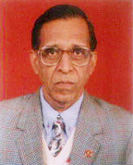Ahimsa-The Essence of Jainism:- By Mr. P. L. Jain
|
Ahimsa - The Essence of Jainism
The word ‘Ahimsa’ meaning, non-violence has a very wide significance and broad interpretation. It indicates both, physical and mental purity, encompassing in itself, the purity of of body, mind and soul. Though the word appears to have a negative sense, since it starts with ‘non’, but it is positive in its approach and creatice in action. The scope of ahimsa is not limited to avoiding violence, if it is going to occur, but it besides itself covers all the other four vows of jain religion, known as ‘panch mahavrata’. These are, ahimsa, truth, non-stealing (achaurya), celibacy (brahmcharya), and non-possession (Aparigraha). Mahavir had classified all the Jaina followers into four categories, called ‘Teerth’, sadhu, sadhwi, srawak and sravika and these panch mahavrata were applicable to all the four categories. For this reason, ahimsa is called ‘param dharma’ or main religion. It is not that so much emphasis has been given to ahimsa only in Jain religion. In most other religions, too, it has been depicted as the major theme and shortest and surest way to salvation, e.g. freedom from all sins and complete rest for the soul for ever (moksha). For example, Sant Tulsi das has said in his Ramayana, In Mahabharata too, ahimsa has been given the highest position among all the reeligious thoughts. It is said that even when Lord Krishna was explaining the warfare to Arjuna during the Mahabharat war, he described the true sense of ‘ahimsa’ and the philosophy behind the word, and trying to win over the enemy through ahimsa. In Puranas also, non-violence has been declared as the holiest among all religions and beliefs. It is written in the epic that one can earn greater ‘punya’, by following ahimsa than by study of all the four vedas and by speaking truth for the whole life. These lines show that non-violence is the highest of all religions. Enough thoughts supporting ahimsa as a major theme can be found in all other religions, like christian, buddh and sikh. Violence is performed by the medium of mind (eu), speech (opu) and body (dk;k). We often ignore the violence performed through our mind and recognise only that which is carried out by sppech and body. It must however be understood that violence indulged in through thoughts is far more serious, since it may give rise to the other two types. Vocal or physical violence can only be performed when such thoughts first come to our mind and compel to carry out the act of violence. Hence, in Jain philosophy, greater stress has been given on the violence performed through thoughts. If we have to stop or avoid any physical violence or speech violence, e.g. hurting anyone by using harsh words, we have to win over our thoughts and stop them to come to our mind. Purity of thoughts thus becomes the basis of non-violence. Raga and dwesha, the two enemies of punya, cause the thoughts to be polluted, leading us to indulge in sinful acts, both in words and deeds. In Jain religion, violence has been classified into two categories, (i) bhava hinsa (violence through thoughts) and (ii) dravya hinsa (violence through bodily actions). To think in mind about hurting others is bhava hinsa, whereas to perform the act of violence id dravya hinsa. The former one may or may not lead to latter type of violence but it is a fact that irrespective of whether the violence is performed or not, coming into mind of such a thought is sufficient sin to cause high degree of karma bandhana. There are two ways in which violence may be performed: (a) One person performs an act of violence but many others suffer from its results. For example, a stage show where one person is shown to kill an animal but many who are witnessing it also share the result of the sin so performed by their sheer participation and then expressing their appreciation for it. (b) Many persons perform a sin but only one suffers from its result. For example, when a war is declared, the person who orders the war is only one and he is mainly responsible for the sin performed, though a large number of persons have to fight under the order of their chief, the aim being to earn a living, not to perform a sin. Everyone therefore, has to keep in mind that violence performed through a single sinful thought in the mind can be much more damaging as it may have a far-reaching and wide-spread effect in causing bodily violence in several forms, at different times. The whole gist of the discussion is that one small violence in any form,just performed through mental activity, can nullify all the good deeds performed over a long period of time, even in the whole span of life. Purity of thought and unconcernedness (sama bhava) can go a long way in keeping us happy and earn punya for our souls. Jay Mahavir.
----------------------------------------------------- Mail to : Ahimsa Foundation |
|
